 |
|

|
 |
TABLE of CONTENTS
 |
District 4 snowplow driver rescues couple whose car rolled into ditch during Feb. 20 storm |
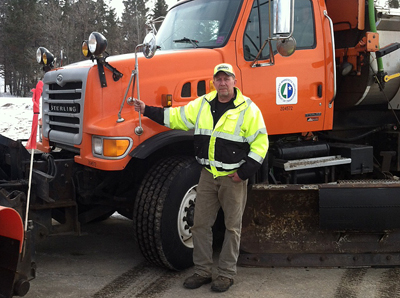
Jeffrey Holte, a snowplow driver from District 4ís Evansville truck station, rescued a couple from a rolled car during a snow storm on Feb. 20 on Interstate 94. Photo by Cristi Field |
Rescuing motorists isn’t explicitly in a snowplow operator’s position description, but Jeffrey Holte found himself doing just that during the winter storm that hit the state in late February.
“When we had that storm blow in on Feb. 20, within a very short period of time our roads went from perfect to a sheet of ice,” said Holte, a transportation generalist who works out of District 4’s Evansville truck station.
Holte was plowing Interstate 94 when he saw a car about a half-mile ahead lose control, roll onto its roof and go into the ditch.
“What I didn’t know was that when the car rolled, it broke out the back window and went into the ditch upside down and backwards, probably still doing 50 mph. It totally packed the inside of the car with snow,” he said.
A woman in her 20s crawled out of the car and ran up to Holte’s truck. She had no coat, gloves or boots on, and was screaming that her boyfriend was trapped and couldn’t breathe because of the crushing snow.
Holte waded through the deep snow to the car and found the driver’s side doors buried. He pried the back passenger door open, only to face a wall of snow.
“I dug snow out by hand between the front bucket seats, which let me find the male driver trapped in the packed snow, hung upside down in his seat belt,” he said.
Holte continued to dig at the packed snow, locating the backrest latch to release and recline the seat for better access to the driver.
“I dug enough snow out that I could belly crawl up to him and find the seat belt release, get him free and pull him out of the car,” he said. “He was pretty cold after being totally packed in by the snow and had frozen hands from trying to get the snow away from his face to breathe.”
Holte said that it probably was only a matter of a few minutes before he was able to free the driver, although “it probably seemed longer to him, as he was the one trapped upside down in the car.”
Holte brought both people back to his truck and got them warmed up while they waited for the State Patrol.
“Not many people get the opportunity to save someone else’s life. I’m proud to be able to say that Jeffrey works for MnDOT and that I have the pleasure to work alongside of him,” said Jeff Perkins, District 4 operations manager.
“I know any other MnDOT employee would have done the same thing, but it makes me feel good that I happened to be in the right place at the right time to assist them,” Holte said.
Wind, drifting snow challenge District 7 crews during Feb. 20-21 storm
Whether it’s rescuing numerous semis and other vehicles along Hwy 60 in the Mountain Lake area or unplugging Hwy 5 from Hwy 212 to Arlington so an ambulance could get through, there are countless stories of MnDOT team work during the blizzard that slammed the state Feb. 20-21.
In south central Minnesota, for example, the weather front deposited six to 10 inches of snow and sleet. Winds picked up during the evening hours of Feb. 20 into Feb. 21, gusting from 35 to 55 mph and causing white-out conditions and drifting snow, according to the National Weather Service
.
“The biggest challenge we face after a wind event like that is clearing out all of the vehicles that got stuck in drifts,” said Jed Falgren, District 7 assistant district engineer for maintenance operations. “There’s a reason why we tell motorists not to travel when conditions are bad.”
Not even snowplows, State Patrol cars, tow trucks and emergency vehicles were immune to the powerful forces of the blizzard, requiring themselves, at times, extraction from the drifting snow.
Falgren said that much of the morning of Feb. 21 was spent painstakingly removing cars from drifts—first blowing a path to a vehicle, then having a tow truck pull it out, then blowing a path to the next vehicle and pulling it out. And repeat.
“Our crews have done a great job throughout this storm and this winter,” said Falgren.
Falgren noted that team work extends beyond just MnDOT, citing the assistance of the Blue Earth County Highway Department, which got involved in the rescue of a local police officer, county sheriff’s deputy and Minnesota state trooper, and helped pull out one of MnDOT’s plows that was involved in the rescue mission.
In an email to all employees following the snow event, Commissioner Charlie Zelle, and deputy commissioners Sue Mulvihill and Tracy Hatch recognized the efforts of snowplow operators and maintenance employees statewide, noting in part:
“…The work that the plow crews did was nothing short of amazing. The prevailing sentiment among long-time MnDOT employees is that this storm was probably the worst we’ve had to deal with since 1991. And back then, it took a couple of weeks to recover!
We are extremely proud and greatly appreciate the work the MnDOT snow and ice crew did over the weekend. They showed, once again, that MnDOT is staffed with dedicated, hard-working public servants who do some of their best work in difficult times.
Winter likely is not done with us. Snowplow operators and maintenance employees who support the plowing operations have worked many long shifts this winter, and will probably have to work a few more. It is good to know that we have such a solid work force that is always ready to clear the roads, no matter the conditions. Thank you!”
Watch District 7 crews in action Feb. 21, 2014 at: www.facebook.com/photo.php?v=10152265641167249&set=vb.153795482248&type=3&theater
|
|
 |
|

|
 |
TABLE of CONTENTS
 |
New parking ramp construction taking place next to Transportation Building |
By Rich Kemp
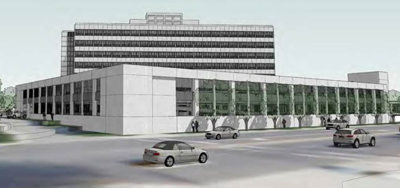
An artist rendering of the parking ramp that is being built on the west side of the Transportation Building. |
Construction of a new parking ramp, Ramp F, is under way directly west of the Transportation Building in St. Paul. The new ramp will accommodate 480 vehicles. Construction will affect parking for Central Office employees and visitors to the Transportation Building.
- The Rice Street entrance to the Transportation Building is closed for the duration of the project.
- Employee disability parking is temporarily relocated in Lot G. A door opener was installed for ease of entry.
- Visitor disability parking is temporarily relocated in Lot D on the north side of the State Office Building.
- Visitor parking is available in Lot AA on the west side of Rice Street between University and Aurora Ave. and at meters on John Ireland Blvd in front of the Transportation Building. Van pools were relocated to Lot X.
- Some Lot G parking contract holders were relocated to Lot X to accommodate employee disability parking.
- Rice Street's east sidewalk is closed during construction.
- There will be increased noise, vibration and dust due to construction activities. There will be increased levels of vibration, mid to late March, while the contractor installs lagging walls. Contractor will monitor the vibration levels.
- Bike lockers and racks by Rice Street doors were moved to the John Ireland side in the plaza, adjacent to the building.
- Parking assignments and wait lists for Ramp F will be determined by a lottery system. Lottery applicants will be assigned a registration number. The lottery will be open for two weeks in May and will use the registration number to randomly select placement of the parking assignment and waiting lists. Learn more about the Department of Administration, Plant Management Division's Ramp F lottery system.
This new ramp should be complete and ready for use by December 2014. For more information, check out the Ramp F website: www.dot.state.mn.us/ramp-f/. |
 |
|

|
 |
TABLE of CONTENTS
 |
Recruitment and retention programs strategies help solve hiring needs |
|
By Sue Roe
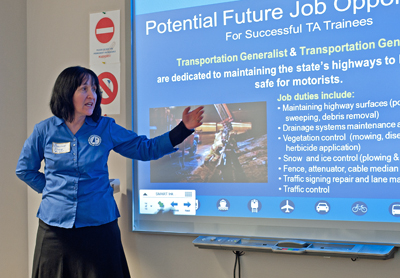
Christine Fisher, Human Resources, explains transportation specialist series positions during a Minnesota Community Advisors on Recruitment and Retention Solutions or MnCARRS, meeting. The group helps recruit persons for all MnDOT jobs from the stateís diverse communities. Photo by David Gonzalez |
Editor's note: This is the second of two stories about what the “face” of MnDOT’s workforce looks like, the hiring challenges and how MnDOT is meeting the challenges of hiring qualified and diverse employees.
More than 35 percent of MnDOT’s workforce will be eligible to retire in the next five years. That has human resources and other departments throughout the districts working to attract qualified and diverse employees to keep up with the predicted shortages.
MnDOT implements several hiring programs and strategies despite the hurdles, such as the shortage of qualified persons due to the smaller population of the generations following the baby boomers, the transient nature of the younger workforce, turnover rates, and the specialized nature of MnDOT jobs.
“We’re investing in our people with robust leadership development programs,” said Karin van Dyck, Central Office human resource director. “MnDOT has a reputation of investing in its employees. Given the talent war, we have had to put more emphasis on recruitment and retention. We will continually seek creative ways to attract and retain talent.”
One of the most successful initiatives is the Seeds student work program, now in its 21st year. The concept is to “grow our own” talent by offering college student worker jobs for minorities, economically disadvantaged, students with disabilities, and students who are veterans. The paid student worker program currently has 25 student workers and has an 82 percent placement rate of Seeds graduates into fulltime MnDOT positions.
“This program is successful because it’s focused on an individual student’s academic goals,” said Sandy Caron, recruitment program supervisor. “We try to place students in positions that match and advance their major.”
The Phoenix internship program is for high school seniors enrolled in Science, Technology, Engineering and Math courses, also known as STEM. This initiative is often a feeder program for the Seeds program. Since 2005, MnDOT has employed 50 student interns and 21 transitioned into the Seeds program.
The Graduate Engineer/Land Surveyor Trainee program recruits, trains and retains civil engineers and land surveyors by offering two-year rotations in the various transportation aspects of engineering. The program currently has 27 fulltime graduate engineer trainees, with 18 percent being female, 15 percent having veteran status and 26 percent are minorities. Caron said after the two-year rotation and successfully getting their engineering degree, these employees are well rounded transportation engineers.
“We have success stories of students going from the Phoenix internship program to Seeds to the trainee program,” said Caron. “These programs provide an opportunity to reach out to our future generations. Early exposure to MnDOT and transportation is important in attracting our future workforce.”
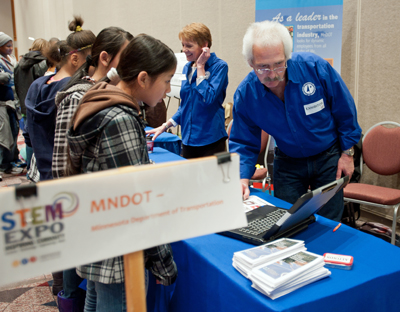
Sandy Caron, recruitment program supervisor, and Gary Troge from Metro construction surveys, talk with high school students during last yearís Minneapolis STEM Expo. Photo by David Gonzalez |
The goal of the Transportation Specialist Series development program is to recruit, hire and retain qualified minorities, women, veterans, and people with disabilities. Since TSS jobs, which include snowplow drivers, construction workers and road maintenance workers, are about one-half of MnDOT’s workforce, the program helps candidates meet minimum qualified standards with curriculum, training and mentoring.
Another program is the Minnesota Community Advisor on Recruitment and Retention Solutions or MnCARRS. It’s a recruitment partnership with the state’s diverse communities to increase the diversity of the applicant and hired pools for all MnDOT jobs. Caron and her staff give presentations to classes and job clubs and participate in partner career events where they help persons set up state resume accounts and job searches and facilitate mock interviews. MnDOT extended the partnership in 2013 by joining with Minnesota Management and Budget to provide community organizations with more employment opportunities.
In 2013, there was a mass hire of transportation associate positions in the Metro District’s maintenance department. After targeted recruitment with MnCARRs partners, 35 percent of the job offers were to candidates who are minority, female, veterans, and persons with disabilities.
Recruitment and retention efforts are effective in attracting a younger and diverse workforce, but many baby boomers are delaying retirement. MnDOT recognizes the strengths of a multi-generational workforce by offering workplace flexibility, training opportunities, teleworking and flexibility to change jobs. The post retirement option allows employees to work reduced and flexible hours while delaying the brain drain associated with experienced workers who have undocumented expertise.
Recruitment and retention fall in line with MnDOT Operations Division’s resource planning initiative. Even though MnDOT has addressed how to meet future workforce needs for years, a district-wide approach toward developing a strategic staffing plan began in fiscal year 2013.
The resource plan and its strategic staffing component set the expectation that all districts and offices will look ahead and plan their staffing strategy based on resources available, according to Mike Barnes, operations division director.
“This strategic framework will enhance our ability to more effectively and efficiently evaluate, develop and implement staffing and operating budget investment decisions over two bienniums,” said Barnes.
“MnDOT has a plan for road and bridge projects 10 to 20 years in advance,” said Judy Schmidt, operations division resource planning manager. Our goal is to build a similar framework for our most valuable asset, our people”. |
 |
|

|
 |
TABLE of CONTENTS
 |
Donated vacation hours sought for Dennis Kinsley |
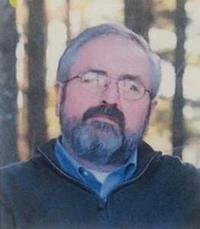
Dennis Kinsley, heavy equipment mechanic in District 6, has been approved for the state vacation donation program. Photo courtesy of District 6 |
Dennis Kinsley, heavy equipment mechanic in District 6, is now eligible for the state vacation donation program, which allows employees to donate up to 40 hours of vacation per fiscal year for approved recipients who have exhausted their sick and vacation leave due to injury or illness.
Kinsley, a 29-year MnDOT employee, had major reconstructive surgery in March 2013 as the result of an earlier bout with cancer. In October 2013, he was diagnosed with colon cancer and bilateral liver metastases. In January, he had colon surgery and will soon resume 4 to 5 months of chemo, followed by liver surgery.
As a result of the extensive medical procedures and ongoing need for medical care, Kinsley has exhausted all his vacation and sick leave. He has been approved for the State Employee Vacation Donation program, which allows employees to donate up to 40 hours vacation per fiscal year to approved recipients.
To donate vacation leave:
- Go to Employee Self Service Website, click on “Other Payroll,” then “Leave Donations.”
- Select the magnifying glass next to “Reserve Bank” and choose “Kinsley”
- Enter the number of hours you wish to donate
- Click on the yellow “Save” box
Donation forms are also available from your Payroll or Human Resources office or at www.mmb.state.mn.us/doc/vacation/pe665.pdf.
|
 |
|

|
 |
TABLE of CONTENTS
 |
Conference highlights advances in multimodal transportation |
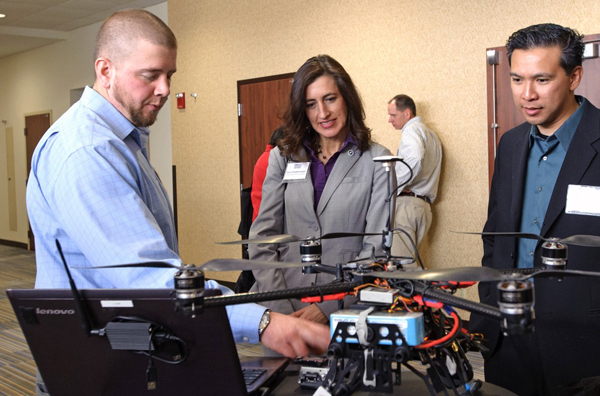
Brian Steuve, Utility Mapping Service, demonstrates a mapping system to Nancy Daubenberger, state bridge engineer, and Darwin Yasis, state geometrics engineer, during the Minnesota Transportation Conference Mar. 4 at the DoubleTree Hotel in Bloomington. The three-day event highlights the latest innovations in transportation from around Minnesota. Look for more about the conference in the March 19 issue of Newsline. Photo by David Gonzalez |
|
 |
|

|
 |
TABLE of CONTENTS
 |
ABC Ramps are more than just parking |
By Sue Roe

Lisa Austin, ABC Ramps coordinator, greets customers during a recent customer appreciation event. The ABC Ramps marketing committee also hosted a carpool appreciation event in January. The ramps are multimodal transportation hubs that give residents and visitors convenient connections between parking facilities and downtown transportation systems. Photo by Sue Roe |
Anyone who has attended an event at Target Field, Target Center or any of the surrounding area has probably parked in the ABC Ramps in downtown Minneapolis. What may not be so widely known is that these ramps are owned by MnDOT.
The three ramps and connecting skyways were built between 1989 and 1992 as part of the Interstate 394 construction project. I-394 has direct access to Ramps A and B and Ramp C is easy to enter for motorists traveling east on I-94. Each ramp is also accessible from downtown streets.
The ramps reduce congestion and preserve air quality by intercepting traffic before it enters the downtown street grid.
“Minimizing traffic congestion benefits both the natural environment and the quality of life for people who live, work and visit downtown,” said Lisa Austin, ramps coordinator.
The ramps are also meant to create a shift in transportation mode from single occupancy vehicles to carpools, van pools and transit. People who carpool are offered deeply discounted parking rates as an incentive to park in the ramps.
Besides the three ramps, which provide 6,600 parking spaces, the lobbies in ramps A and B are hubs for existing bus services and provide connections to nearby light rail and the Northstar Commuter Rail Line. The ramps house locker and shower facilities for bicyclists, covered motorcycle parking and connections to the Minneapolis skyway system and Hiawatha light rail line. The MnPASS carpool lanes and the Cedar Lake Bike Trail also connect to the ramps.
“The ramps are unique multimodal transportation hubs that give residents and visitors convenient connections between parking facilities and downtown transportation systems,” said Austin. “They are much more than parking.”

Ramp A is the largest ramp in downtown Minneapolis. It is one of three ramps owned by MnDOT. Photo by David Gonzalez |
Cost of construction was about $100 million, paid with 90 percent federal funds, 5 percent state and 5 percent city of Minneapolis funds. Although MnDOT owns the ramps, they are managed by the city of Minneapolis. A third party operates the day-to-day activities. The ramps are technically considered bridges since they were built across the I-394 right of way, Austin said.
The ramps and skywalks include innovative technology that enhances safety, encourages multimodal travel and reduces carbon footprints. Austin said digital displays in the ramps help motorists know about traffic conditions, weather and detours. The city of Minneapolis works closely with MnDOT’s Regional Traffic Monitoring Center with variable message signs on the city streets. The automated gates in and out of the ramps can track the number of vehicles. A modern security system links all the ramps’ cameras into one central monitoring room. Electric vehicle charging stations will be installed soon.
Parking for events at Target Center, Target Field and the surrounding entertainment district provided 37 percent of the ramps’ revenues in 2011, compared to 16 percent in 2007 when Target Field was built. The ramps have generated discretionary funds in excess of expenses since 1997.
“The ramps and transportation options were main reasons the site was selected for the Twins’ ballpark,” said Austin. “Construction of Target Center, Target Field, the Hiawatha light rail, Northstar terminal and the revitalization of the Hennepin entertainment district all came after the ramps were built.”
Austin said the ramps are well-positioned to incorporate future developments. One proposal under consideration is a golf dome on top of Ramp A. A private developer proposed a two-story building with golf facilities, training room, restaurant, driving range and playing areas. MnDOT and the city of Minneapolis are negotiating terms to allow the city to research the project’s feasibility.
Operating the ramps takes the cooperation of stakeholders from city, county, state, and federal agencies, private sector businesses, legislative members, and citizen groups, known as the ABC Ramps Working Group.
“This group is a way for all stakeholders to communicate on projects and issues affecting the ramps,” said Austin, who leads the group. “It’s a great public-private partnership that ensures the ramps are sustainable and innovative by offering a clean, safe and convenient environment for users of multimodal travel.” |
 |
|

|
 |
TABLE of CONTENTS
 |
Using images and graphics effectively in documents and emails |
By Becky Dahlberg

Graphic of the alternative text box. Alt text makes images accessible to those who canít see them. |
People who are visually impaired use special software called screen reading software that literally reads print materials aloud. Screen readers can read text and characters quite well but cannot interpret images, graphics, pictures or symbols.
Does this mean we should avoid using images in our documents or emails? Absolutely not! We just need to keep in mind that whenever we include images, we also need to provide a way for those using screen reading software to hear and understand through words what others see and understand through sight. This is done using alternative text – or alt text for short.
Alt text is heard by those who use screen reading software – there is no obvious effect or change to the image itself. The alt text simply makes the image accessible to those who cannot see it. Because of the difference between hearing and seeing, however, it is especially important to write clear, concise and meaningful alt text to help ensure equal understanding.
Here are some quick tips:
- Be clear – Aim for simple and clear alt text language. While no one intentionally writes in a confusing manner, try typing a title and description of the image and then take a mental step back and reread what you’ve written. Does the language clearly describe the image? Consider your audience: Would they easily understand it? Would you understand it if it was read out loud to you?
- Be concise – Keep your alt text short and sweet. No need to describe every detail of the image or table in question. Instead, consider the goal of the image/table and how it adds value to its surrounding text, and then briefly summarize that in your title and description.
- Be meaningful – Customize your alt text to fit your image or table. Being meaningful is closely related to being clear and concise. If your image or table is complicated, describe the information in a more detailed way (without losing clarity!). If your image/table is simple, a simple title and description will do. For instance, a graph showing data changes over the past several years in an annual report will likely need more context than an image of a child on a bike that’s only meant to add visual appeal to an event flyer by breaking up the event text. The graph is more closely tied to the overall content than the photo.
Forgot how to format your images with alt text? Visit Accessibility tips – Creating accessible Word documents for a refresher.
For more information on alt text or accessibility, visit the communications accessibility webpage. |
 |
|

|
 |
TABLE of CONTENTS
 |
What's new on the web |
MnDOT Technical Certification Program
MnDOT’s Technical Certification Program website was recently updated in the newest web templates and reorganized with a crisp, clean design.

Graphic of the Technical Certification website. |
For those unfamiliar with the Office of Construction and Innovative Contracting program, the TCP is federally mandated. It’s required for MnDOT to receive federal funding for highway and bridge projects. It ensures that qualified and certified technicians are testing and inspecting materials used on our projects.
About 3,500 technicians from around the state and neighboring states are trained and certified/recertified each year. Class attendees include technicians from MnDOT, city and county agencies, consulting and testing firms, and private contractors. In addition to the classroom training courses, the TCP now offers two online recertification courses.
Find course listings, registration information, new technologies, TCP handbook, and more on the TCP website at www.mndot.gov/const/tcp/ |
 |
|

|
 |
TABLE of CONTENTS
 |
The Color Purple: A Guide to Driving During a Snowstorm for Dummies |
By Bob Filipczak

The roads around Minnesota on Feb. 21 were pretty bad. When MnDOT advises no travel, that means being on the roads is dangerous. Photo by David Gonzalez |
There are five colors on the 511mn.org site to tell you about road conditions during a snow storm: green (good), blue (fair), pink (difficult), purple (hazardous/ travel not advised), and red (closed). Let’s talk about that fourth one for a minute. What does “travel not advised” really mean?
If you look at the color key, it’s pretty clear purple means:
This is a very serious roadway situation that is used when crews are still out performing snow and ice operations, but the existing conditions are so treacherous that just being on the roads is dangerous. Ice covered roadways due to freezing rain and near blizzard conditions with visibilities below 1/4 mile are two examples of when this would be used.
Even though I’m the social media guy for MnDOT, and even though I tell thousands of our followers all the time that they should not go out if the color is purple, I went out in the Feb. 21 storm. Here’s my rationale--my wife needed to get to the airport for a flight to Arizona, so at least one of us could escape this frozen winter.
While that seemed reasonable when we got in the car, it did not sound so good nine hours later when I got home, minus the car. I have driven most of the very treacherous Hwy 1 in California in a red convertible. I have driven the Beartooth pass in a 79 Vega. None of this prepared me my adventure on the road that day.
After some storms, you have probably heard that the roads are like “skating rinks”? No, skating rinks are flat and you can only drive a short distance on them. Our highways are not flat, so a road with an inch of uncompromising ice on it is more like traveling along the top of a large pipeline on roller skates.
Because I’m a guy, I thought I could make it. Most guys do. Maybe we should change the key to read “travel not advised and this means you, guys.” As you might have guessed, I didn’t make it. After dropping off my wife, I got knocked into a ditch on a rural road by a snowdrift that didn’t care I was driving an SUV. I got stuck once more that day, and finally had to abandon my car three-quarters of a mile from home because the road was blocked by drifting.
So if you are determined to go out in this stuff, here are some things to add to your preparations. In addition to assembling the emergency kit recommended by the Department of Public Safety, you should:
- Take $120 in cash with you--$100 for the tow truck and $20 to tip the driver if he shows up within 90 minutes of your call. If you use a credit card, he has to call it in which often takes longer than the actual removal from the ditch.
- Make sure you have GPS so you can tell the tow truck driver exactly where you are. Some of the rural roads may not be that well marked. Fortunately for me, my Waze app told me where I was even though I drive the road every day.
- Drink lots of milk. The calcium will give you strong fingernails that will not break off as you dig them ever deeper into the steering wheel.
- Leather gloves—not for warmth but so you have something good to bite down on as the stress and anxiety inches up your jaw.
- Leave at home your expectations that you will beat the odds and make it through the storm unscathed.
- If you have room, put a snowmobile in the back of your vehicle so you can get home regardless of conditions.
- Get a dog, so someone will be happy to see you when you finally get home.
|
 |
|
| |
|



